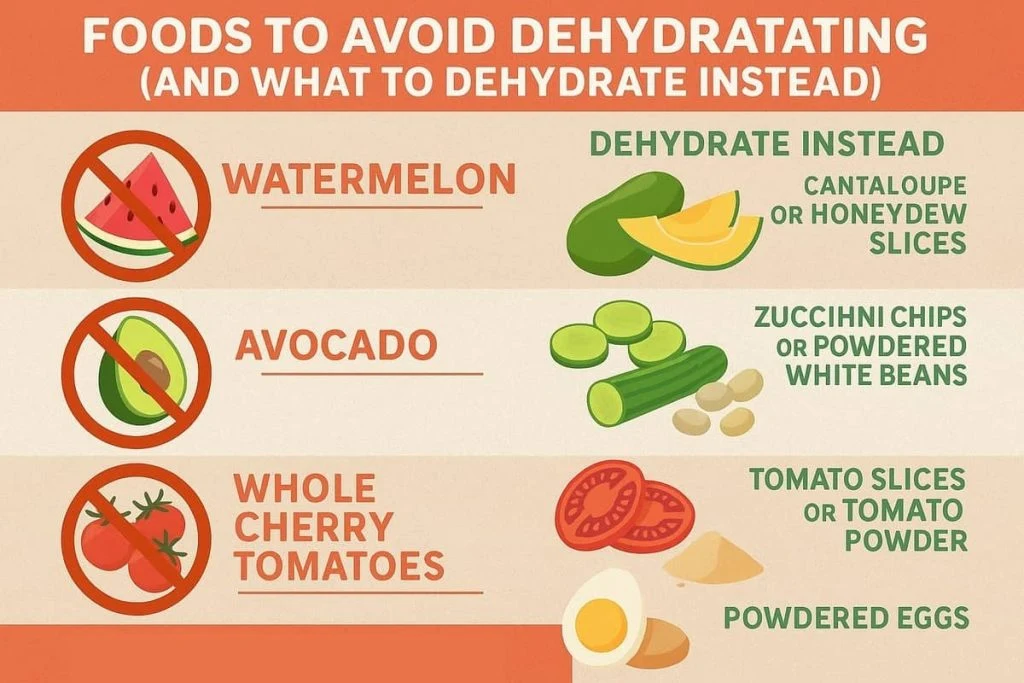Some foods just aren’t worth dehydrating—either they go bad, taste awful, or never rehydrate right. After dozens of batches and a few brick-hard disasters, I’ve got a running list of what not to bother with—plus better alternatives that actually work.
❌ 1. Watermelon
Why it failed:
Sounds fun. Tastes like sticky sadness. Watermelon takes forever to dry and turns into a weird, chewy fruit leather that doesn’t store well.
What I dehydrate instead:
➡️ Cantaloupe or honeydew slices
These hold their shape better, dry faster, and make a solid sweet snack.
❌ 2. Avocado
Why it failed:
High fat = bad news for dehydration. The texture gets chalky, and the fat can go rancid in storage, even in vacuum-sealed bags.
What I dehydrate instead:
➡️ Zucchini chips or powdered white beans
Not the same flavor, but they add healthy fat alternatives or bulk to meals.
➡️ Related: What Not to Dehydrate: Foods That Fail or Get Unsafe
❌ 3. Whole Cherry Tomatoes
Why it failed:
The skins trap moisture inside, so you either end up with moldy centers or spend hours babysitting them. They look fine until you try to store them.
What I dehydrate instead:
➡️ Tomato slices or tomato powder
Slice Roma tomatoes thin or make a paste, dehydrate it, and powder it for soups and sauces.
👉 How to Make and Use Dehydrated Powders
❌ 4. Hard-Boiled Eggs
Why it failed:
High protein, high sulfur, and high regret. The smell is nuclear, and the rehydrated version has a gritty, spongy texture that’s better left uneaten.
What I dehydrate instead:
➡️ Powdered eggs (commercial or freeze-dried)
If you really want shelf-stable eggs, buy them. Trust me.
❌ 5. Raw Potatoes (Without Blanching)
Why it failed:
Raw potatoes turn black, taste bitter, and stay rock-hard when rehydrated—unless you blanch them first.
What I dehydrate instead:
➡️ Blanched potato slices or hashbrowns
Boil 2–3 minutes, cool, then dry. Rehydrates like a dream in soups or skillet meals.
👉 Need more help? Check How to Dehydrate Frozen Vegetables (Without Prepping Them)
❌ 6. Refried Beans
Why it failed:
It can work, but it dries into cement if not done just right. And rehydrating it requires a LOT of stirring. Not worth the shelf space.
What I dehydrate instead:
➡️ Cooked whole black beans or lentils
Easier to dry, lighter to store, and more flexible for meals.
👉 How to Build a Pantry Around Dehydrated Food
❌ 7. Store-Bought Yogurt
Why it failed:
Even full-fat yogurt flakes don’t store well. They go soft and lose flavor fast. Plus, many have added sugar or fillers that cause spoilage.
What I dehydrate instead:
➡️ Greek yogurt drops (homemade, low-sugar)
Spoon dots on parchment, dry until crispy. Eat them fast—they’re not for long-term storage, but make a great snack or mix-in.
Final Thoughts

Some food flops are just part of the dehydrating journey. But if it’s fatty, sugary, or overly wet—it probably won’t dehydrate well or store long. That said, every failed tray teaches you something. Just don’t feel bad about skipping the trendy stuff.
Stick with foods that dry well, store safely, and actually reheat into something edible. Your future self will thank you.
Thanks for stoppin’ by!
Jelly Grandma
👉 Want more tips like this? Check out 8 Beginner Tips for Dehydrating Food – Avoid the Common Mistakes for everything from drying gear reviews to pantry storage hacks.
Anne James—lovingly known as Jelly Grandma—is a professional canner, seasoned home cook, and lifelong preserver of traditional Southern skills. With over 55 years of hands-on experience in canning, gardening, cooking, and quilting, Anne brings generations of wisdom to every guide she writes.
Featured in both local media and by national brands like Hershey, Anne now shares her knowledge through PreservingSweetness.com and her YouTube channel, helping others rediscover the “old ways” of living well and making things from scratch.

